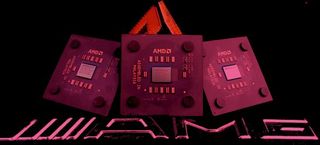Overclocking AMD's Thunderbird and Duron Processor
Introduction

I certainly agree that Tom's Hardware Guide may not be the strong promoter of overclocking anymore that it once used to be. I decided to keep overclocking at a quieter and more reasonable level, simply because we, as the largest PC hardware publication on the Internet, are aware of the responsibility for our readers. Pushing people into doing something that could possibly damage their computer system or at least cost them important data is something we prefer to leave to others. However, running your processor beyond its official spec does not necessarily implicate any damage whatsoever, as long as you stay within reason. Overclocking can be a very cost effective way to improve the performance of your system, and getting involved with it will most likely improve your knowledge as well, because you might have to try out and learn several things about your system until you will finally succeed.
Tom's Hardware has got a rather long tradition to inform its readers on how to modify their systems to run their processors beyond spec and thus faster. We were the first to report about the bus speed increase to 83 MHz in Pentium class systems in November 1996, we disclosed the 'B21'-trick for Celeron processors in 1998 and last year we published all the details to produce the famous 'gold finger' overclocking devices for SlotA Athlon processors. Following this tradition we are proud to be the first who can supply you with information on how to overclock AMD's brand new Athlon/Thunderbird and Duron processors for SocketA or Socket462.
Duron And Thunderbird
You are certainly aware of it. In the last three weeks AMD released the successor of the successful Athlon processor, still called Athlon, as well as the new low-cost Duron processor. The new Athlon is using the so-called 'Thunderbird' chip, which places the processor core as well as the second level cache onto one die, making the new Athlon faster as well as smaller. This 'Thunderbird-Athlon' comes with a new package, called 'SocketA', which plugs into a Socket with 462 pins vs. the 'SlotA' cartridge solution used by its predecessor. Duron is based onto the same architecture as 'Thunderbird', with the only difference that it comes with only a quarter of Thunderbird's L2-cache. If you want to learn more about those two AMD-CPUs please read those two articles:
- Thunderbird Finally Fully Fledged
- The Celeron-Killer - AMD's New Duron Processor
AMD Processors Vs. Intel Processors
In the last 9 months we have learned that AMD has finally reached a position where it can supply processors that are fully competitive to the counterparts from Intel. When AMD's Athlon processor was released in August 1999 it was even significantly ahead of any Intel product and it took AMD's arch enemy no less than three months to come up with a solution that could properly compete with Athlon. Since AMD's Thunderbird release on June 5, 2000 both processor makers are pretty much on par, so that it is up to the customer to decide whose solution he prefers. Basically, AMD's new Thunderbird is superior to Intel's 'Coppermine' Pentium III in floating point intensive applications, while Pentium III can score points with software that makes heavy usage of Intel's proprietary 'streaming SIMD extensions', short 'SSE'. Since last Monday (June 19, 2000) AMD is now also in the position to attack Intel's low-cost processor 'Celeron'. At the same price AMD's new Duron processor is significantly faster than the Intel's Celeron.
The hardware cracks out there are not quite satisfied yet though. Running AMD vs. Intel processors while keeping them within spec may be one thing, but would the new AMD-CPUs be able to live up to the performance achieved by overclocked Intel processors? So far Intel had the almost untouchable image as the producer of the most overclockable microprocessors worldwide. Especially the attractively priced Celeron used to be overclocker's best friend . AMD processors were known to be much closer to the limits, making them rather touchy CPUs for the tweakers around the world.
Now, since AMD is finally also offering processors in a 'one-chip' solution, things might have changed. Could it be that the new AMD-processors can finally reach the good overclocking results achieved with Intel-CPUs? Would Thunderbird and Duron be able to possibly even surpass Pentium III and Celeron?
Stay on the Cutting Edge
Join the experts who read Tom's Hardware for the inside track on enthusiast PC tech news — and have for over 25 years. We'll send breaking news and in-depth reviews of CPUs, GPUs, AI, maker hardware and more straight to your inbox.
Current page: Introduction
Next Page Overclocking Duron And Thunderbird - The TheoryMost Popular

